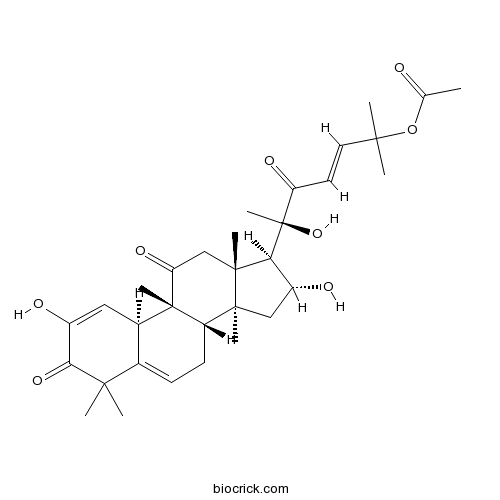Citrullus lanatus
Citrullus lanatus
1. The products in our compound library are selected from thousands of unique natural products; 2. It has the characteristics of diverse structure, diverse sources and wide coverage of activities; 3. Provide information on the activity of products from major journals, patents and research reports around the world, providing theoretical direction and research basis for further research and screening; 4. Free combination according to the type, source, target and disease of natural product; 5. The compound powder is placed in a covered tube and then discharged into a 10 x 10 cryostat; 6. Transport in ice pack or dry ice pack. Please store it at -20 °C as soon as possible after receiving the product, and use it as soon as possible after opening.
Natural products/compounds from Citrullus lanatus
- Cat.No. Product Name CAS Number COA
-
BCN2300
Cucurbitacin E18444-66-1
Instructions

Differential roles of melatonin in plant-host resistance and pathogen suppression in cucurbits.[Pubmed: 29766569]
Since the 1950s, research on the animal neurohormone, melatonin, has focused on its multiregulatory effect on patients suffering from insomnia, cancer, and Alzheimer's disease. In plants, melatonin plays major role in plant growth and development, and is inducible in response to diverse biotic and abiotic stresses. However, studies on the direct role of melatonin in disease suppression and as a signaling molecule in host-pathogen defense mechanism are lacking. This study provides insight on the predicted biosynthetic pathway of melatonin in watermelon (Citrullus lanatus), and how application of melatonin, an environmental-friendly immune inducer, can boost plant immunity and suppress pathogen growth where fungicide resistance and lack of genetic resistance are major problems. We evaluated the effect of spray-applied melatonin and also transformed watermelon plants with the melatonin biosynthetic gene SNAT (serotonin N-acetyltransferase) to determine the role of melatonin in plant defense. Increased melatonin levels in plants were found to boost resistance against the foliar pathogen Podosphaera xanthii (powdery mildew), and the soil-borne oomycete Phytophthora capsici in watermelon and other cucurbits. Further, transcriptomic data on melatonin-sprayed (1 mmol/L) watermelon leaves suggest that melatonin alters the expression of genes involved in both PAMP-mediated (pathogen-associated molecular pattern) and ETI-mediated (effector-triggered immunity) defenses. Twenty-seven upregulated genes were associated with constitutive defense as well as initial priming of the melatonin-induced plant resistance response. Our results indicate that developing strategies to increase melatonin levels in specialty crops such as watermelon can lead to resistance against diverse filamentous pathogens.
Genome-wide identification and comprehensive analysis of microRNAs and phased small interfering RNAs in watermelon.[Pubmed: 29764387]
MicroRNAs (miRNAs) are a class of endogenous small non-coding RNAs involved in the post-transcriptional gene regulation and play a critical role in plant growth, development and stress responses. Watermelon (Citrullus lanatus L.) is one of the important agricultural crops worldwide. However, the watermelon miRNAs and phasiRNAs and their functions are not well explored.
Grafting of watermelon (Citrullus lanatus cv. Mahbubi) onto different squash rootstocks as a means to minimize cadmium toxicity.[Pubmed: 29723053]
None
Spatiotemporal Dynamics of Whitefly Bemisia tabaci (Hemiptera: Aleyrodidae) in Commercial Watermelon Crops.[Pubmed: 29669025]
Spatiotemporal dynamics studies of crop pests enable the determination of the colonization pattern and dispersion of these insects in the landscape. Geostatistics is an efficient tool for these studies: to determine the spatial distribution pattern of the pest in the crops and to make maps that represent this situation. Analysis of these maps across the development of plants can be used as a tool in precision agriculture programs. Watermelon, Citrullus lanatus (Thunb.) Matsum. and Nakai (Cucurbitales: Cucurbitaceae), is the second most consumed fruit in the world, and the whitefly Bemisia tabaci (Gennadius) (Hemiptera: Aleyrodidae) is one of the most important pests of this crop. Thus, the objective of this work was to determine the spatiotemporal distribution of B. tabaci in commercial watermelon crops using geostatistics. For 2 yr, we monitored adult whitefly densities in eight watermelon crops in a tropical climate region. The location of the samples and other crops in the landscape was georeferenced. Experimental data were submitted to geostatistical analysis. The colonization of B. tabaci had two patterns. In the first, the colonization started at the outermost parts of the crop. In the second, the insects occupied the whole area of the crop since the beginning of cultivation. The maximum distance between sites of watermelon crops in which spatial dependence of B. tabaci densities was observed was 19.69 m. The adult B. tabaci densities in the eight watermelon fields were positively correlated with rainfall and relative humidity, whereas wind speed negatively affected whiteflies population.
Phytol isolated from watermelon (Citrullus lanatus) sprouts induces cell death in human T-lymphoid cell line Jurkat cells via S-phase cell cycle arrest.[Pubmed: 29608981]
The phytol isolated from watermelon (Citrullus lanatus) sprouts inhibited the growth of a human T-cell leukemia line Jurkat cell and suppressed tumor progression in a xenograft model of human lung adenocarcinoma epithelial cell line A549 in nude mice. To elucidate the mechanisms underlying the phytol-induced cell death in the present study, we examined the changes in cell morphology, DNA fragmentation, and intracellular reactive oxygen species (ROS) levels and performed flow cytometric analysis to evaluate cell cycle stage. There were no significant changes in apoptosis, autophagy, and necrosis marker in cells treated with the phytol. But, we found, for the first time, that phytol remarkably induced S-phase cell cycle arrest accompanied with intracellular ROS production. Western blot analyses showed that phytolinduced S-phase cell cycle arrest was mediated through the decreased expression of cyclins A and D and the downregulations of MAPK and PI3K/Akt. The tumor volume levels in mice treated with phytol were lower than those of non-treatment groups, and it showed very similar suppression compared with those of mice treated with cyclophosphamide. Based on the data of in vitro and in vivo studies and previous studies, we suggest phytol as a potential therapeutic compound for cancer.


